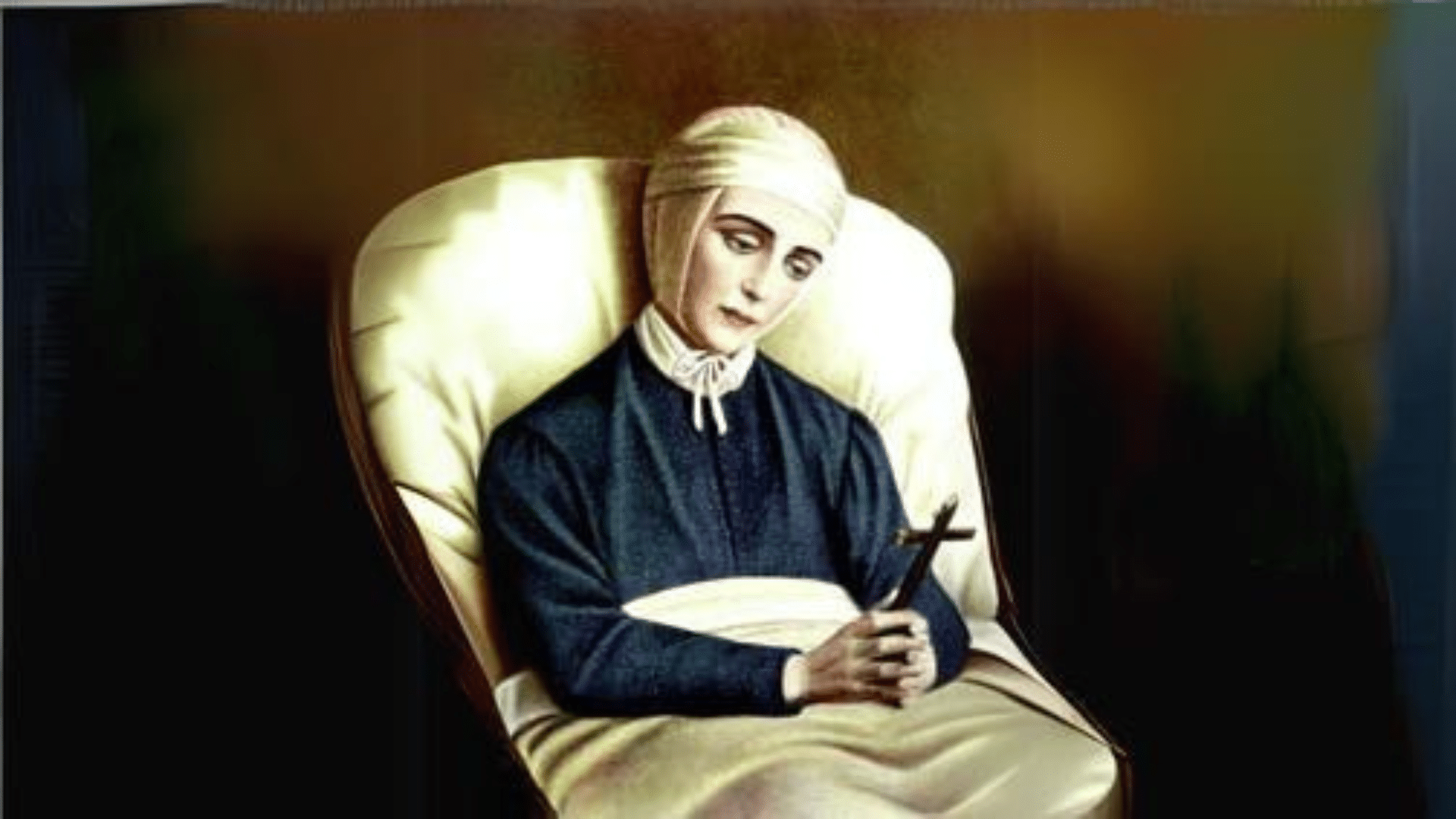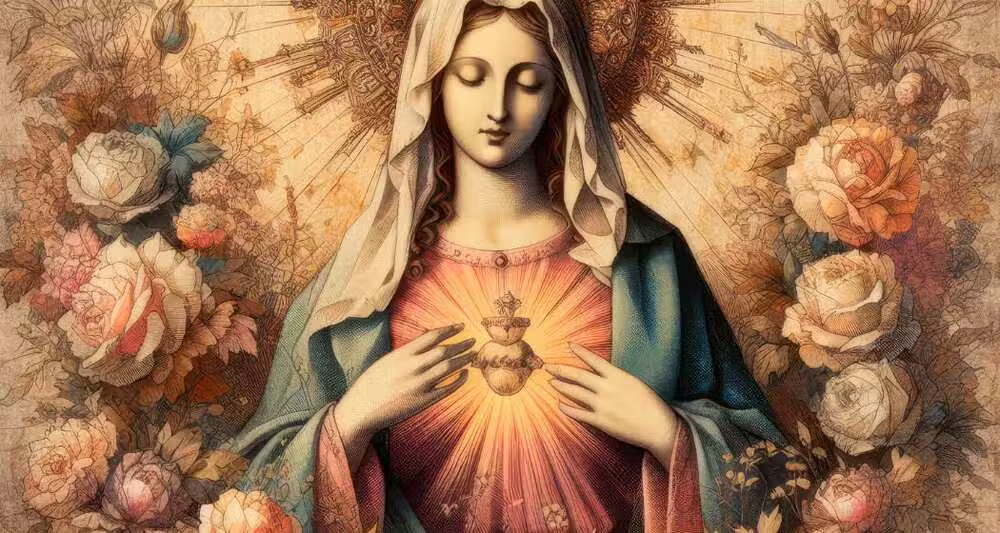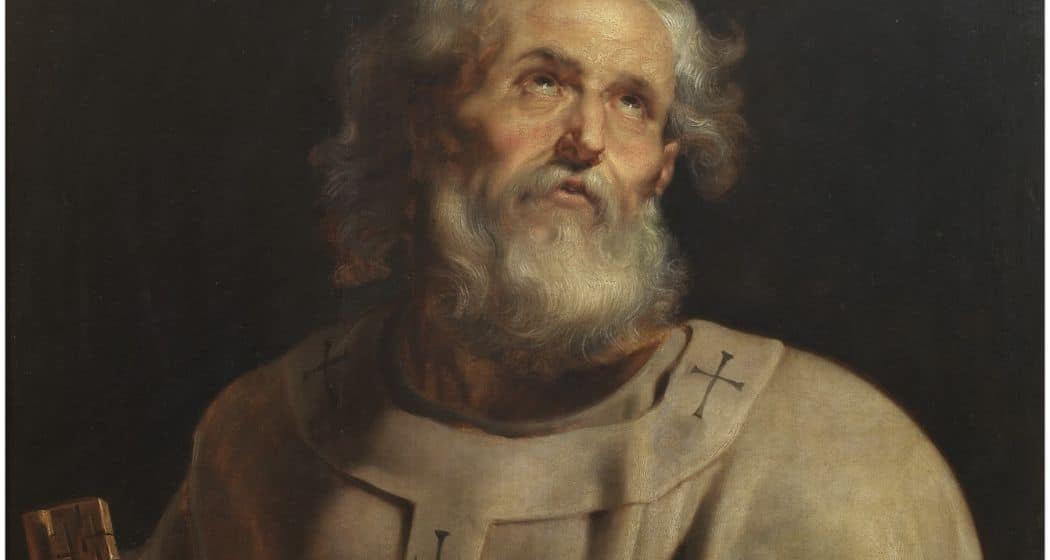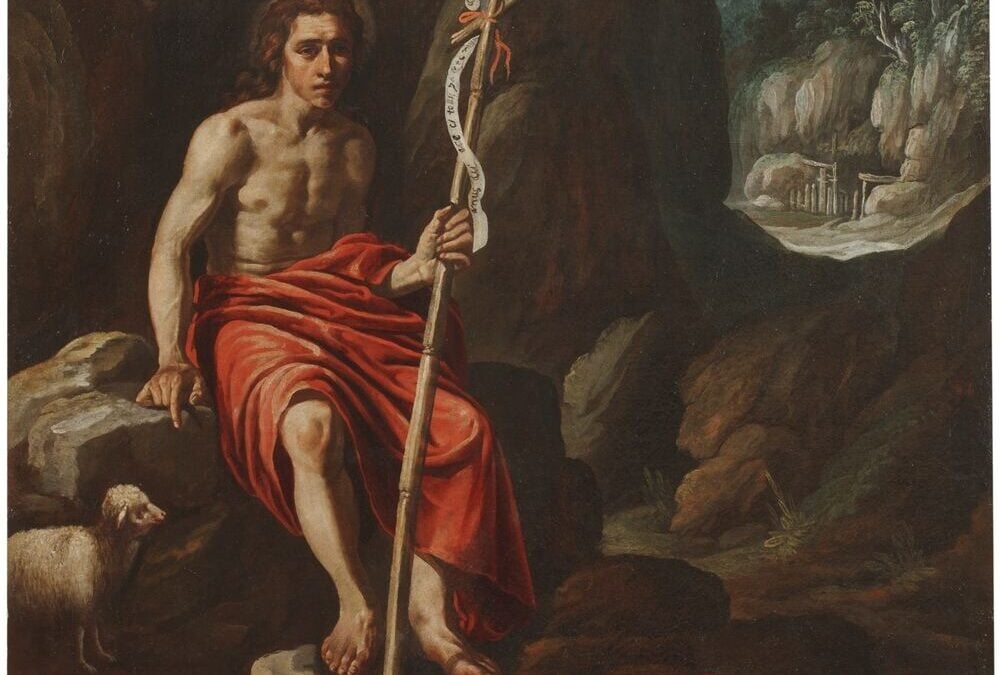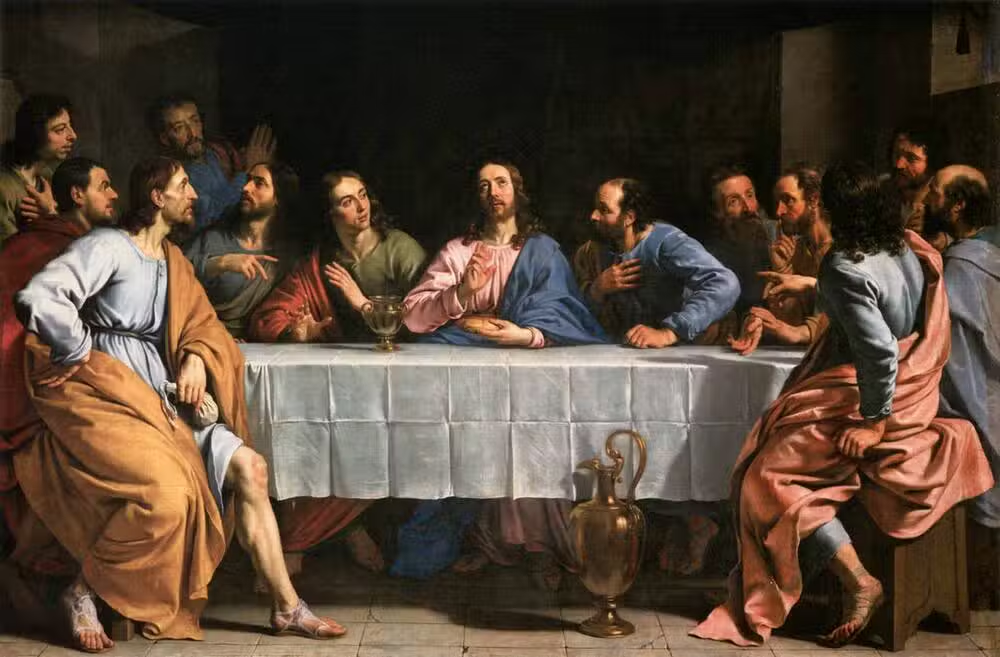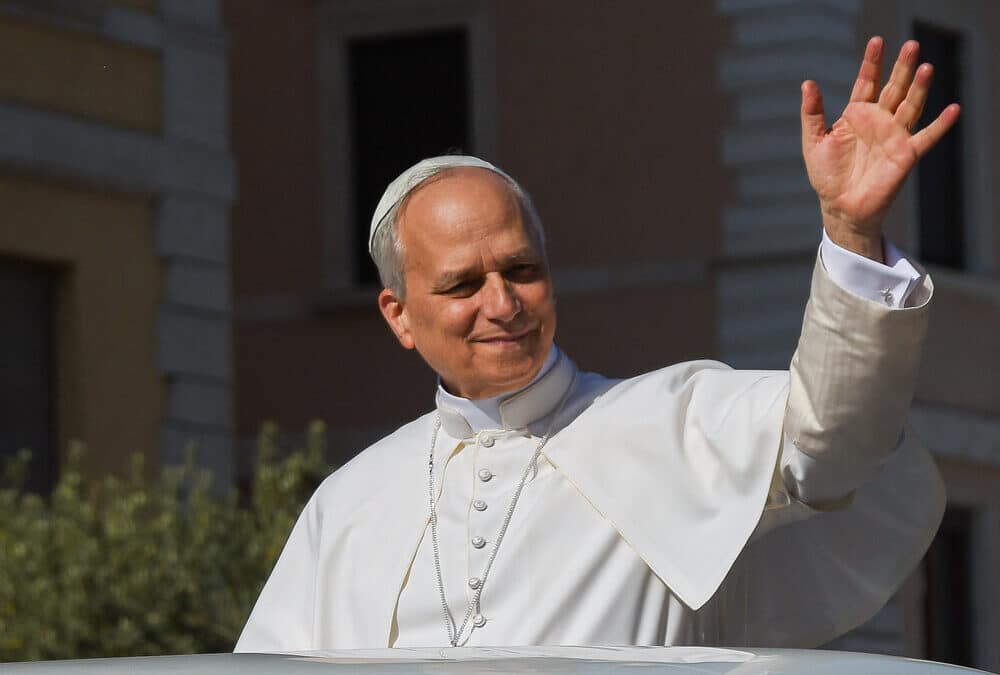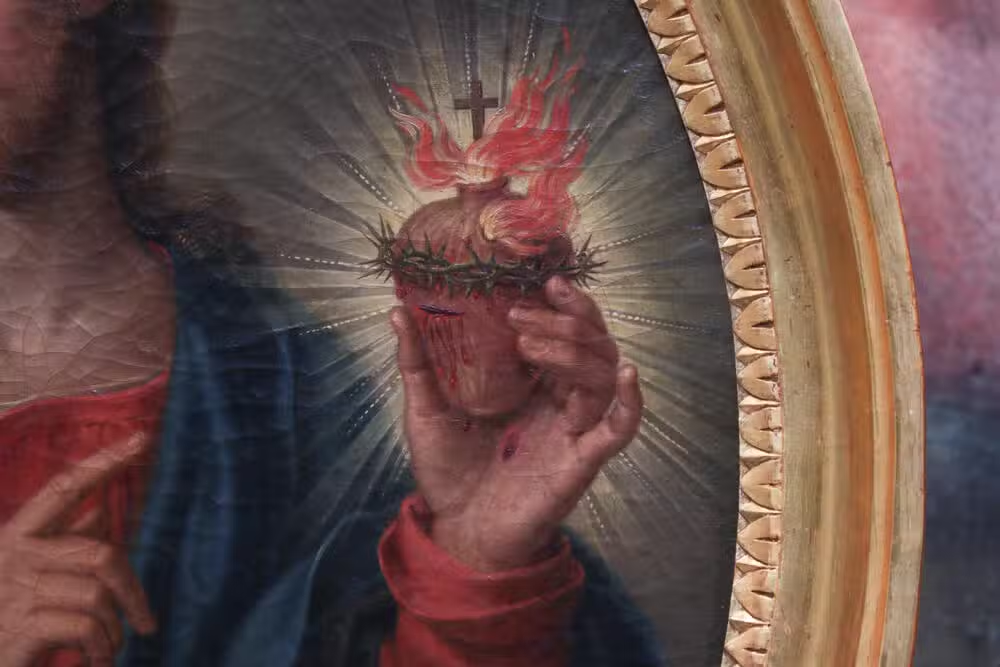Catherine of Emmerick is a significant figure in the history of the Catholic Church, not only for her mystical visions but also for her dedication to the service of God and to the reflection of the Mass. mass. From his childhood, he showed a deep inclination towards prayer and religious life, which was reflected in his constant search for the divine presence through the Mass. Catherine’s life, characterized by sacrifice and devotion, continues to be a beacon of inspiration for many of the faithful.
You can use the Catholic Mass Times app to find the nearest Catholic church with Mass, Confession, and Adoration schedules. It will surely help you! Download it now.
Catherine Emmerich: A Life of Visions and Suffering
Catherine of Emmerick, born on September 8, 1774 in the village of Flamschen, near the town of Coesfeld, grew up in a large family with nine siblings. Since her childhood, she had to help with housework and farm work, which limited her school attendance. However, her knowledge of religious matters was remarkable, and from an early age, she was attracted to prayer and religious life. This inclination was reflected in his devotion to the reflection of the Mass, which he attended whenever he could.
Three years of her youth were spent on a neighboring farm working as a servant, and she later learned to sew in Coesfeld, where she also enjoyed visiting the old churches and participating in the reflection of the mass. In addition, he used to pray in the great Via Crucis of the city, reflecting his deep religious devotion.
Catherine longed to enter a convent, but due to financial difficulties, she could not realize her wish immediately. She returned home and worked as a seamstress, which brought her into contact with many families. In his free time, he continued to participate in the reflection of the Mass and to seek a deeper religious life.
After being rejected by several convents due to lack of a dowry, she was finally accepted by the Poor Clare nuns of Münster on the condition that she learn to play the organ. Although he did not have the opportunity to learn to play it, his dedication to the Söntgen family, with whom he lived, demonstrated his willingness to sacrifice for others. Catalina continued to participate in the reflection on the mass regularly, strengthening their faith.
In 1802, Catherine entered the convent of Agnetenberg in Dülmen together with her friend Klara Söntgen and, the following year, took her monastic vows. Despite her humble origins and being initially underestimated, Catherine actively participated in the life of the convent and was always willing to perform the most difficult tasks. Her strict observance of the rules and her devotion to the reflection of the Mass made her stand out, although it also generated misunderstandings.

Between 1802 and 1811, Catherine suffered several illnesses and great pain. In 1811, the convent was closed due to secularization, and Catherine was taken in by the refugee priest Abbé Lambert in Dülmen. Shortly thereafter, she became seriously ill and bedridden. During this time, she received the stigmata, and the young physician Dr. Franz Wesener, impressed by her, became her friend and assistant, documenting their encounters in detail.
Catalina’s love for others was evident in all her actions. Despite being bedridden, she made clothes for needy children and graciously welcomed the many visitors who came seeking comfort and prayer. Her devotion was reflected in every reflection of the mass offered for her intentions and in the prayers she offered for those who visited her.
Clemens Brentano, a German poet, played a crucial role in preserving Catherine’s visions. After his first visit in 1818, he stayed five years in Dülmen to transcribe his visions, which were later published. These visions not only inspired many people but also influenced artistic and literary representations of the Passion of Christ, enriching the experience of Mass reflection for many.
In the summer of 1823, Catherine became even weaker and offered her sufferings in union with those of Jesus for the salvation of souls. She died on February 9, 1824 and was buried in the Dülmen cemetery, where many attended her funeral. Rumors about the theft of his remains led to the exhumation of his grave, and his body was found in perfect condition.
Catherine of Emmerick’s life was marked by a deep union with Christ, and her devotion to the reflection of the Mass was a manifestation of that relationship. Her love and service to others, even in the midst of suffering, make her a model of faith and devotion. Through her visions and writings, Catalina continues to inspire many to deepen their faith and live with integrity, reflecting on the importance of Mass reflection in the Christian life.
Catherine of Emmerick was a fervent devotee of the Blessed Virgin Maryand his life is a testimony of service and love. His sufferings, accepted as a service in favor of salvation, and his constant prayer reflect a life dedicated to God. The reflection of the Massas the center of his spiritual life, invites us to contemplate the mystery of the cross and to follow his example of faith and devotion on our daily journey.
Church of the Visions

As a child, Anne Catherine Emmerick used to pray in this church. On the altar, there is the famous Coesfeld Cross, mentioned since 1312 (fourth photo). From this church begins the Way of the Cross of Coesfeld, approximately 10 kilometers long, which Anne Catherine mentions in several accounts. One of the most outstanding accounts is the one that describes how, after praying for a long time, she felt the crucified Jesus leaning towards her (section 16 entitled “The Way of the Cross of Coesfeld” and link to it).
The Coesfeld Cross has an unusual “Y” shape, instead of the usual “T” shape with two crossed timbers. In “The Bitter Passion of our Lord Jesus Christ”, Ana Catalina describes the cross of Jesus in the shape of a “Y”, while the crosses of the thieves are in the shape of a “T”. A century later, another German mystic, Theresa Neumann, also described the cross of Jesus in the shape of a “Y”, coinciding with Anne Catherine’s vision.
- For more information about this Church, visit the website of St Lamberti
- Location:Markt 18, 48653 Coesfeld, Germany
Beatification and its Meaning

The beatification of Catherine of Emerick in 2004 by Pope John Paul II in Pope John Paul II was an official recognition of his holiness and his contribution to the Church. This event not only celebrated his life and virtues, but also underscored the continuing relevance of his message for Catholics today. Catherine’s beatification encourages us to look to her life as a model to follow and to seek to live our lives with the same faith and devotion.
Thus says St. John Paul II on the present Blessed “Blessed Anna Katharina Emmerick contemplated “the sorrowful passion of our Lord Jesus Christ” and experienced it in her body. The fact that the daughter of poor peasants, who earnestly sought closeness to God, became the well-known “mystic of Münster” is the work of divine grace.
In the midst of her material poverty, she possessed a deep inner life. As we are impressed by her patience in enduring bodily weakness, we are also impressed by the strength of character of the new blessed and her solidity in faith. For this, she drew strength from the Holy Eucharist. Her example opened the hearts of the poor and rich, of simple and educated people, with a view to a loving devotion to Jesus Christ. Even today, she transmits to all the message of salvation: By His wounds we have been healed (cf. 1 Peter 2:24).”
For Catholics today, Catherine of Emerick is a reminder that true holiness is not found in great works or public recognition, but in the daily life of faith, sacrifice and service to God and neighbor. His life challenges us to live with integrity, to deepen our relationship with God and to always seek the divine will in all our actions.
The Influence of Catherine d’Emmerick and the Cinema

Mel Gibson, in creating “The Passion of the Christ,” was significantly inspired by Catherine de Emmerick’s visions. The film, released in 2004, seeks to offer an intense and emotional depiction of the last twelve hours of Jesus’ life. Many of the graphic details and specific scenes in the film, which are not found in the Gospels, come from Catherine’s visions. This influence is reflected in the reflection of the Mass, allowing the faithful to contemplate the suffering of Christ with renewed depth.
For example, the scene in which Jesus is brutally scourged by Roman soldiers and the detailed agony he experiences on the road to Calvary are elements Gibson took directly from Catherine’s descriptions. Gibson’s intention was to draw the viewer into a deep reflection on the suffering of Christ, a goal that aligns with Catherine’s spirituality and her emphasis on the Passion. By watching the film, viewers can experience a more intense and moving reflection of the Mass, recalling the sacrifice of Jesus.
Clemens Brentano, the German poet who transcribed Catherine’s visions, played a crucial role in preserving and disseminating her mystical experiences. Without her dedication, Catalina’s visions might have been forgotten. His work, “The Sorrowful Passion of Our Lord Jesus Christ,” has been a primary source of inspiration for many artistic and literary interpretations, including Gibson’s film. Brentano’s transcriptions have allowed Catherine’s visions to enrich many people’s reflection on the Mass over the years.
For many, the connection between Catherine of Emmerick and “The Passion of the Christ” is more than just a literary inspiration. It is a spiritual bridge that unites personal devotion with a visual and cinematic representation of Jesus’ sacrifice. The film has helped bring Catherine’s visions to a global audience, allowing many to experience a deeper and more emotional Mass reflection on the Passion of Christ. This spiritual connection underscores the importance of meditation and prayer in our daily lives.
Since its premiere, “The Passion of the Christ” has left a significant mark both culturally and spiritually. The film has been seen by millions of people around the world and has been the subject of much debate and analysis. The influence of Emmerick’s Catherine on Mel Gibson’s script and direction has played a crucial role in its reception and in the way viewers experience the Passion of Christ. Reflection of the Mass, the film invites the faithful to contemplate the sacrifice of Jesus in a deeper way.
The detailed and moving depiction of Christ’s sufferings in the film has led many viewers to a deepening of their personal devotion. By viewing the scenes based on Catherine of Emmerick’s visions, the faithful feel called to a deeper reflection of the Mass, contemplating the sacrifice of Jesus in a new and meaningful way. This deepening of personal devotion is one of the film’s most enduring legacies.
.
Reflection on the Mass
In these stories, Catherine describes in detail and mystical depth how Jesus, during the Last Supper, transforms the bread and wine into his Body and Blood, bestowing on his apostles, and on all of us, the supreme gift of his sacrificial love. Through his words, we are called to contemplate the mystery of transubstantiation and to deepen our understanding and devotion to the sacrament of the Eucharist. As I read these passages, let me reflect on the immensity of Christ’s love and how each reflection of the Mass brings us closer to his divine presence.
In the following paragraphs, we present some fragments from Passion and Resurrection of Jesus by Anne Catherine Emmerich in order to promote reflection on the institution of the Eucharist and the Holy Mass
“Jesus still prayed and taught: the words went out of his mouth like the fire of light and entered into the apostles, except Judas. He took the paten with the pieces of bread (I do not know if he had placed it on the chalice), and said, Take and eat; this is my Body, which will be given for you. He extended His right hand as if to bless and, while doing so, a great radiance came from Him: His words were luminous and the bread entered the mouths of the apostles as a radiant body:
I saw them all penetrated with light; only Judas was dark. Jesus presented the bread first to Peter, then to John; next He beckoned Judas to come near; this was the third to whom He presented the Sacrament, but it was as if the words of the Lord were taken out of the mouth of the betrayer and returned to Him. I was so agitated, I couldn’t express what I was feeling. Jesus said to him, “Do quickly what you want to do”. Then he gave the Sacrament to the other apostles who came forward two by two.”
“Jesus raised the chalice by its two handles to the height of his face and pronounced the words of consecration: as he said them, he was transfigured and transparent: he seemed to pass all whole in what he was about to give them. He gave Peter and John a drink from the cup that was in his hand and placed it on the table. John poured the divine blood from the chalice into the cups and Peter presented them to the apostles who drank in pairs from the same cup.“.
“From ancient times there was the custom of breaking bread and drinking the food in it; it was a sign of fraternity and love that was used to give the chalice at the end of welcome or to say goodbye; I think there must be something about this in the holy Writing. Jesus today elevated this practice to the dignity of the Most Holy Sacrament:
until then it had been a symbolic and figurative rite. This was one of the charges brought against Caiaphas for the betrayal of Judas: Jesus was accused of having added to the Passover ceremonies something new, but Nicodemus proved from the Scriptures that it was an ancient usage Jesus placed himself between Peter and John: the doors were closed; everything was done with mystery and solemnity. When the chalice was taken out of the bag, Jesus prayed and spoke very solemnly. I saw Jesus explaining the Supper and the whole ceremony: it seemed to me like a priest teaching the others how to say mass”.
“John and Peter poured water on his hands over the dish where the loaves had been; he took with the spoon, which he took from the foot of the chalice, some of the water poured on his hands and poured it on theirs; then the dish was passed around the table and they all washed their hands with it. I do not remember if this was the exact order of the ceremonies: what I do know is that everything reminded me, in an extraordinary way, of the Holy Sacrifice of the Mass.
Jesus became more and more affectionate; he told them that he was going to give them all that he could give them. had, that is, Himself, as if He had melted all in love. I saw it become transparent; it looked like a luminous shadow.”
Catherine of Emmerick’s legacy lives on in the Catholic Church, not only for her visions, but for her example of faith and unconditional love. His devotion to the reflection of the Mass and his ability to offer his suffering as an act of love for God and others invites us to follow his example. Catherine teaches us that true holiness is found in the daily life of faith and service, and that, through reflection on the Mass, we can deepen our relationship with Christ and live with greater integrity and devotion.
Catherine Emmerich was a German mystic and stigmatist from the 19th century, whose visions have inspired many faithful. Her detailed accounts of Christ’s Passion and the life of the Virgin Mary have been collected in books that have strengthened the faith of generations. Her testimony is a source of deep spirituality and reflection.
If you want to learn more about figures who have shaped Christian spirituality, don’t hesitate to explore our publications.
You can use the Catholic Mass Times app to find the nearest Catholic church with Mass, Confession, and Adoration schedules. It will surely help you! Download it now.
What Were Catherine Emmerich's Main Visions About the Passion of Christ?
Catherine Emmerich had detailed visions about the Passion of Christ, describing with precision the sufferings of Jesus from Gethsemane to the Crucifixion. She recounted the flagellation, the crowning with thorns, and the Way of the Cross with a richness of detail that impacted many faithful. Her visions inspired works such as Mel Gibson’s film The Passion of the Christ, and were collected in the book The Dolorous Passion of Our Lord Jesus Christ, based on the writings of Clemens Brentano.
What Revelations Did Catherine Emmerich Have About the Virgin Mary and the Holy Family?
Among her revelations, Catherine Emmerich described unknown episodes from the life of the Virgin Mary, such as her childhood, the presentation in the temple, and the flight to Egypt with Saint Joseph and the Child Jesus. She provided details about the house of the Holy Family in Ephesus, which led to archaeological investigations. Her accounts highlight Mary’s profound humility and mission in the history of salvation.
How Were Catherine Emmerich's Revelations Recorded and Published?
Catherine Emmerich’s visions were recorded by Clemens Brentano, who visited the German mystic and transcribed her revelations with great fidelity. These were published in several works, including The Dolorous Passion of Our Lord Jesus Christ and The Life of the Blessed Virgin Mary. Although there has been debate about the accuracy of the transcriptions, her visions have inspired the devotion of many faithful.
Where Do Catherine Emmerich's Remains Rest and What Is Her Status in the Church?
Catherine Emmerich’s remains rest in the church of Dülmen, Germany, a place of pilgrimage for many devotees. She was beatified in 2004 by Pope John Paul II, recognizing her heroic virtues and her impact on Christian spirituality. Although her visions are not part of the official Magisterium, they have been a source of inspiration and reflection for numerous faithful.

